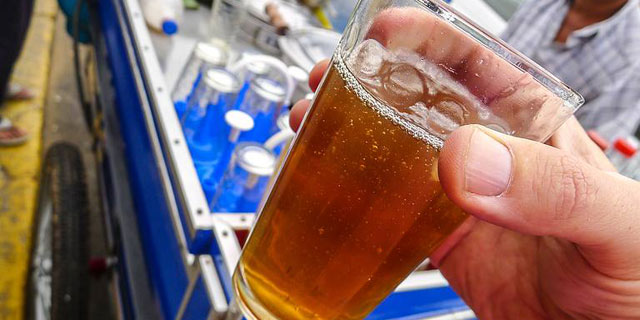In quick succession Carlos pulls bottles from a rack that lines his street cart. He pours a bit of the contents from each bottle into a large glass partly filled with tea. One of the people waiting in line for a ‘shot’ is a woman who mumbles an ingredient for her tonic. Carlos adds yet another liquid.
“I want it muy amargo. I have cancer and this will help me. I buy one glass every morning,” the woman says and then finishes her drink in one go.
As I travel through Peru and meet other emolienteras, vendors of emoliente, I realize there is not a single, universally agreed upon definition of this drink. Like Peru’s cuisine, it is characterized by a mixture of colonial and indigenous elements with regional flavors and touches.
What you can say about emoliente is that it is a hot beverage typically found in Peru, and it is said to have medicinal properties. Emolienteras explain that it helps digestion and works as a diuretic, that the brew is good for all organs, and that it may be imbibed in an effort to ward off a cold. Though traditionally sold on street corners, nowadays you may also find it in bars and restaurants.
Emoliente likely has roots in ancient Greece, where barley water was a common drink. The Spanish likely then added cinnamon and lemon juice to the beverage and took the brew with them when they set out to conquer Latin America. Over the centuries, Peruvians, and later other Latin Americans, brewed their own healthier versions that included herbs and seeds.
These days the basic ingredients are toasted barley, flax seeds, and lime juice. Others vary per region and even per vendor. Among the (medicinal) herbs, plants and seeds are: boldo, aniseed, dried grass, an herb called horse tail, lemon grass, cat’s claw, llantén (plantain leaf), and noni. All ingredients are put in a pot of water, boiled, and then the mixture is strained.
You can tell the vendor what you’d like to have added to this herbal infusion; for example, alfalfa juice, cinnamon, lime juice, honey, and aloe vera. In the case of the latter, the vendor will cut open an aloe vera leaf and scrape out the slimy substance. In order that the aloe vera mix well with the rest of the tea, he will pour the liquid back and forth between two glasses until it is well combined. Apart from eating ceviche, you can hardly go more local than starting your day with one of these herbal teas.


![Making Mealtime Matter with La Familia: Easy Sofrito [Video]](https://thelatinkitchen.com/wp-content/uploads/2015/10/sofrito-shutterstock__0-500x383.jpg)
![Easy Latin Smoothies: Goji Berry Smoothie [Video]](https://thelatinkitchen.com/wp-content/uploads/2015/12/goji_berry-shutterstock_-500x383.jpg)
















![Fun and Fast Recipes: Fiesta Cabbage Salad [Video]](https://thelatinkitchen.com/wp-content/uploads/2015/11/fiesta_cabbage_slaw-shutterstock_-500x383.jpg)









